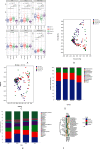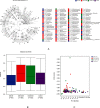Unique composition of ocular surface microbiome in the old patients with dry eye and diabetes mellitus in a community from Shanghai, China
- PMID: 38200418
- PMCID: PMC10777597
- DOI: 10.1186/s12866-023-03176-2
Unique composition of ocular surface microbiome in the old patients with dry eye and diabetes mellitus in a community from Shanghai, China
Abstract
Background: This study investigates the variations in microbiome abundance and diversity on the ocular surfaces of diabetic patients suffering from dry eye within a community setting. The goal is to offer theoretical insights for the community-level prevention and treatment of dry eye in diabetic cohorts.
Methods: Dry eye screening was performed in the Shanghai Cohort Study of Diabetic Eye Disease (SCODE) from July 15, 2021, to August 15, 2021, in the Xingjing community; this study included both a population with diabetes and a normal population. The population with diabetes included a dry eye group (DM-DE, n = 40) and a non-dry eye group (DM-NoDE, n = 39). The normal population included a dry eye group (NoDM-DE, n = 40) and a control group (control, n = 39). High-throughput sequencing of the 16 S rRNA V3-V4 region was performed on conjunctival swab from both eyes of each subject, and the composition of microbiome on the ocular surface of each group was analyzed.
Results: Significant statistical differences were observed in both α and β diversity of the ocular surface microbiome among the diabetic dry eye, diabetic non-dry eye, non-diabetic dry eye, and normal control groups (P < 0.05).
Conclusions: The study revealed distinct microecological compositions on the ocular surfaces between the diabetic dry eye group and other studied groups. Firmicutes and Anoxybacillus were unique bacterial phyla and genera in the dry eye with DM group, while Actinobacteria and Corynebacterium were unique bacterial phyla and genera in the normal control group.
Keywords: 16S rRNA; Diabetes; Dry eye; Microbiome; Ocular surface.
© 2024. The Author(s).
Conflict of interest statement
Competing interests. The authors declare no competing interests.
Figures



Similar articles
-
Punctal occlusion for dry eye syndrome.Cochrane Database Syst Rev. 2017 Jun 26;6(6):CD006775. doi: 10.1002/14651858.CD006775.pub3. Cochrane Database Syst Rev. 2017. PMID: 28649802 Free PMC article.
-
Genetic influence on the composition of the ocular microbiome in preweaned beef calves.J Anim Sci. 2025 Jan 4;103:skaf153. doi: 10.1093/jas/skaf153. J Anim Sci. 2025. PMID: 40319373
-
What is the impact of microbiota on dry eye: a literature review of the gut-eye axis.BMC Ophthalmol. 2024 Jun 19;24(1):262. doi: 10.1186/s12886-024-03526-2. BMC Ophthalmol. 2024. PMID: 38898418 Free PMC article.
-
[Relationship Between Different Traditional Chinese Medicine Syndrome Types and Gut Microbiota in Patients With Type 2 Diabetes Mellitus].Sichuan Da Xue Xue Bao Yi Xue Ban. 2025 Mar 20;56(2):389-399. doi: 10.12182/20250360507. Sichuan Da Xue Xue Bao Yi Xue Ban. 2025. PMID: 40599291 Free PMC article. Chinese.
-
Autologous serum eye drops for dry eye.Cochrane Database Syst Rev. 2017 Feb 28;2(2):CD009327. doi: 10.1002/14651858.CD009327.pub3. Cochrane Database Syst Rev. 2017. PMID: 28245347 Free PMC article.
Cited by
-
Alterations of ocular surface microbiome in glaucoma and its association with dry eye.J Med Microbiol. 2025 May;74(5):002013. doi: 10.1099/jmm.0.002013. J Med Microbiol. 2025. PMID: 40359128 Free PMC article.
References
Publication types
MeSH terms
LinkOut - more resources
Full Text Sources
Medical

